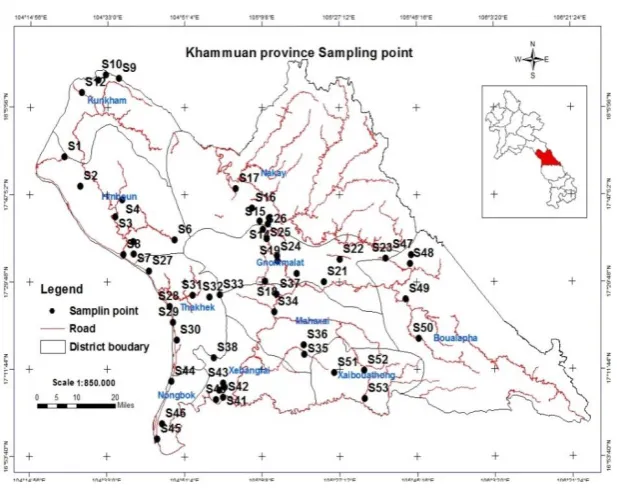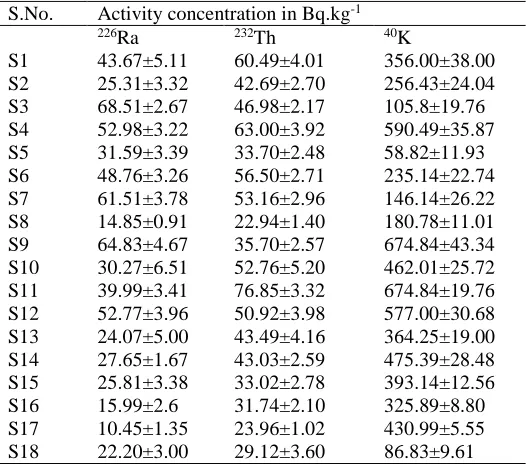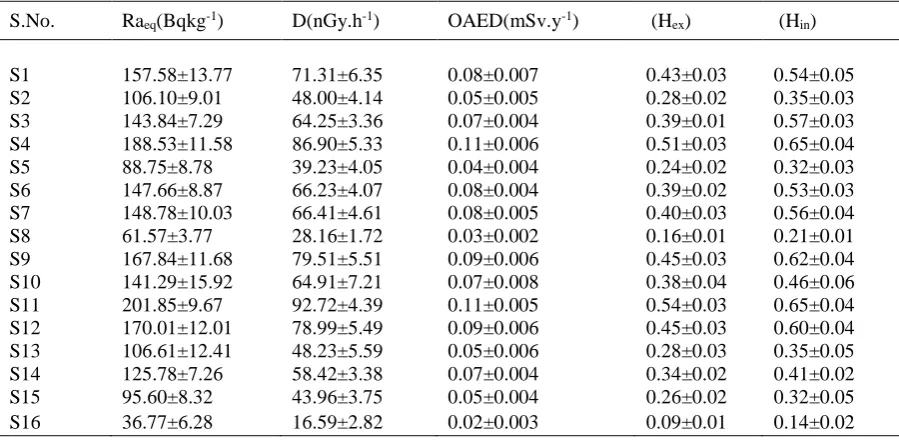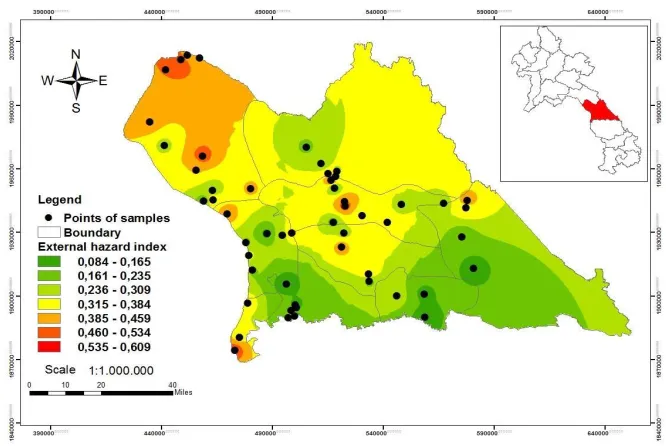22
Original Article
Assessment of Natural Radioactivity and Associated Radiation
Hazards in Soils samples from Khammuan Province, Laos
Somsavath Leuangtakoun
1, 2,*, Bui Van Loat
1, Bui Thi Hong
1,
Duong Duc Thang
3, Sounthone Singsoupho
21Faculty of Physics, VNU University of Science, 334 Nguyen Trai, Hanoi, Vietnam 2National University of Laos, P.O.Box: 7322, Dongdok Vientiane, Lao
3Institute for Nuclear Science and Technology, 179 Hoang Quoc Viet, Cau Giay, Hanoi, Vietnam
Received 25 January 2019
Revised 23 April 2019; Accepted 24 April 2019
Abstract: In order to assessment of Natural Radioactivity and Associated Radiation Hazards in soil samples, activity concentration of naturally occurring radionuclides was measured by using a gamma spectrometer with a high energy resolution HPGe detector. The average radioactivity
concentrations of 226Ra, 232Th and 40K in the surface layers (5‑30 cm depth) collected from
Khammuan province, Laos, were 32.57± 3.35 Bq.kg-1,41.10±3.04 Bq.kg-1 and 295.07± 17.36
Bq.kg-1respectively. From the activity concentration of 226Ra,232Th and 40K, we derived the
parameters using the assessment of the radiological hazard from exposure to these soil samples. The average absorbed dose rate of all measured samples is 52.02±4.09nGy.h-1, while the average
annual effective dose in the outdoor due to gamma radioactivity is found to be (0.060±0.005) mSv.y-1.The average values for radium equivalent activity, external and internal hazard indices
were found to be (114.07± 4.70) Bq.kg-1, (0.31± 0.02) and (0.39± 0.03) respectively.
Keywords: Natural radionuclides, Radium Equivalent Activity, Absorbed gamma dose rate, Annual effective dose rate, Khammuan province.
1. Introduction
Naturally occurring radionuclides are widespread in the earth’s environment during the geological formation, particularly in soil, water, air, rocks and plants. In the world average, approximately 85% of the annual total radiation dose of any person comes from natural radionuclides of both terrestrial
________
and cosmogenic origins [1]. The major sources of radiological exposure are natural radionuclides namely 238U and 232Th series and 40K, which appear in the earth’s crust since its origin. The external
exposure of most of these radionuclides to the human body is cause by their gamma radiation [2, 3]. The 226Ra subseries contribute about 98% of the external γ dose induced by whole 238U series.
Radiological hazard parameters are calculated based on the specific radioactivity of 40K, 226Ra and 232Th in the soil samples [4]. Thus, the studies of natural radioactivity in environment is necessary not
only for the achieving the impact of radiation, but also for benefit of public health [5]. The main objective of this study was to identify and determine natural radionuclide activity concentrations in soil samples collected from 53 locations in Khammuan Province, Laos to evaluate the annual effective dose from outdoor terrestrial radiation. The natural gamma radiation determined in this study would be useful for establishing baseline data on the gamma background radiation levels indifferent areas of Khammuan Province, Laos for assessment of radiation exposures to the population.
2. Materials and methods
2.1. Study area
Khammuan Province one of the provinces of Laos on latitude 17.6384° N and longitude 105.2195°E as shown in Figure 1, covering an area of 16.315 km2. The province is bordered
by Bolikhamsai Province to the north and northwest, Vietnam to the east, Savannakhet Province to the south and Thailand to the west. Many streams flow through the province to join the Mekong River. Some of the major rivers which originate in the mountains of this province arethe Xaybungfai River (239 km), Nam Hinboun, NamTheun and Namgnum River, situated between the Mekong and the Annamite Range. TheKhammuan Plateau features gorges, grottoes, jungles, limestone hills and rivers.
2.2. Sample preparation and measurements
Soil samples were collected from 53 different locations in Khammuan Province closed to the populated agriculture field and tourist areas. At every sampling site, the soil samples were collected from the surface layers (5‑30cm depth) using a spade. After removing organic materials and piece of stones, at the laboratory the samples were dried in an oven at about 110°C for 6 hours. After drying, the samples were crushed and served with a mesh having holes each of diameter of 0.2 mm.
Afterward, the homogenized samples were weighed and placed in polyethylene box with diameter of 7.5 cm and height of 3.0 cm. The time needed for establishing secular equilibrium between 226Ra
with 214Bi and 214Pb is about 4 weeks. The gamma spectra of the IAEA –RGU1 reference and the soil
samples were carried out by low background gamma spectroscopy using ORTEC P-type coaxial high purity Germanium (HPGe). The detection efficiency of detector is 40% relative to a 3”3” NaI(Tl) detector and a FWHM of 2 keV at 1332 keV of 60Co.
2.3. Experimental determination of radiation hazards
2.3.1. Determination of activity concentration
The activity concentration of a certain radionuclide was calculated using the following equation [6, 7].
A(Bq.kg
-1) =
𝑛𝜀×𝐼𝑒𝑓𝑓×𝑚𝑠 (1)
where 𝑛 is the net gamma counting rate (counts per second) for a peak at a given energy, 𝜀 is the detected efficiency of a specific gamma-ray, 𝐼𝑒𝑓𝑓 is the intensity of the gamma-ray in radionuclidesand
𝑚𝑠is the weight of the soil sample.
The activity of 226Ra was determined based on 295.57 keV and 351.9 keV photo peaks emitted
from 214Pb and 609.3 keV and 1120.3 keV peak from 214Bi. The activity of 232Th was extracted by
338.6 keV and 911.1 keV gamma rays of 228Ac and 583.19 keV gamma ray of 208Tl, respectively. The
activity of40K was calculated directly from the gamma line of 1460.82 keV.
2.3.2. Radium Equivalent Activity
Radium equivalent activity (Raeq): The significance of 226Ra,232Th and 40K concentrations was
defined in terms of radium equivalent activity in Bq.kg-1. Ra
eq was calculated from equation [8]:
Raeq = ARa +1.43ATh + 0.077AK (2)
where ARa, ATh and AK are the activity concentrations of 226Ra, 232Th, 40K, respectively. It has been
assumed that 370 Bq.kg-1of 226Ra,259 Bq.kg-1 of 232Th and 4810 Bq.kg-1 of 40K produce the same
gamma dose rate. The maximum value of Raeq in all soil samples is required to be less than the limit of
370 Bq.kg-1 recommended by the Organization for Economic Co-operation and Development for safe
use, i.e.to keep the external below 1.5 mSv.y-1[1].
2.3.3. Air absorbed gamma dose rate (Dair):
The absorbed dose rates in outdoor air (Dair) at 1 m above the ground surface were calculated. The
conversion factors used to compute absorbed gamma-ray dose rate in air corresponds to 0.46 nGy.h-1
for 226Ra, 0.62 nGyh-1 for 232Th and 0.042 nGy.h-1 for 40K. Therefore, D
air can be calculated using
equation [2].
The population-weighted values give an absorbed dose rate in outdoor air from terrestrial gamma radiation a value of 59 nGy.h-1 [1].
2.3.4. Outdoor Annual Effective Dose (OAED)
To estimate outdoor annual effective doses (OAED), we used the conversion dose (0.7 Sv.Gy-1)
and the outdoor occupancy factor (0.2) [2]. The effective dose equivalent rate was calculated from equation [6]:
OAEDE (mSv.y-1)= D
air× 8760 (h.y-1)× 0.2 × 0.7 (Sv.y-1) × 10-6 (4)
2.3.5. External and internal Hazard Index
Radiation exposure due to 226Ra,232Th and 40K may be external. This hazard is defined in terms of
external or outdoor radiation hazard index and denoted by Hex, this can be calculated using
equation[6]:
Hex = ARa /370+ ATh /259+ AK /4810 <1 (5)
Internal hazard index (Hin) is given by equation [5]:
Hin =ARa /185+ ATh /259+ AK /4810 <1 (6)
Hex and Hin are must be less than one for safe use of samples and in for the radiation hazard to be
negligible.
3. Results and discussion
3.1. Activity Concentration of 226Ra, 232Th and 40K
The activity concentrations of radionuclides have been determined by gamma spectrometry technique for 53 soil samples collected from Khammuan Province in Laos. The results of activity concentration for the radionuclides 226Ra, 232Th and 40K are shown the Table 1.
Table 1.Activity concentration (Bqkg-1) of 226Ra, 232Th and 40K in soil samples from surface layer (5-30 cm).
S.No. Activity concentration in Bq.kg-1 226Ra 232Th 40K
S19 57.65±4.58 76.09±3.57 336.05±16.55 S20 55.26±2.53 38.91±2.10 40.69±9.21 S21 51.35±7.00 48.89±5.29 67.75±23.60 S22 22.20 ± 2.34 39.05 ± 3.78 376.75 ± 18.71 S23 24.10 ± 1.52 36.17 ± 2.35 352.96 ± 21.65 S24 43.37 ± 2.90 64.34 ± 4.63 455.19 ± 21.10 S25 14.13±1.7 17.26±1.49 140.19±6.68 S26 46.02 ± 2.98 72.78 ± 4.68 992.42 ± 62.88 S27 38.87±3.83 62.63±3.06 560.44±14.91 S28 29.95 ± 2.71 30.32 ± 1.96 127.55 ± 8.29 S29 44.49±2.08 36.22±1.89 356.87±21.53 S30 32.44 ± 1.95 29.09 ± 1.67 140.06 ±8.85 S31 9.08±4.62 19.82±3.79 131.07± 13.82 S32 49.03±3.22 34.34±2.42 44.86±10.82 S33 35.70±4.35 58.59±3.41 409.35±16.42 S34 34.99 ± 0.61 66.18 ± 3.60 371.40 ± 6.90 S35 21.19±3.18 25.89±2.23 210.29±10.03 S36 30.77±3.4 67.17±3.00 280.53±12.66 S37 31.15±3.82 36.46±3.11 259.64± 14.09 S38 10.64 ± 2.54 10.72 ±2.72 68.14 ± 6.29 S39 37.21±4.19 20.52±1.09 395.45±16.36 S40 23.81±4.72 29.75±3.74 104.38±16.33 S41 20.72±3.41 12.3±1.05 103.83±12.30 S42 17.96±2.47 24.84±2.08 38.88±8.50 S43 14.76±3.51 19.26±2.81 76.66±12.01 S44 33.13±3.4 48.97±2.70 440.43±13.17 S45 43.42±3.29 70.71±2.72 633.93± 14.11 S46 34.06 ± 2.05 49.97 ± 3.01 381.93 ± 23.08 S47 44.18±3.79 64.14±3.00 723.51±15.34 S48 30.38±2.94 55.92±2.57 343.46±11.24 S49 21.57±3.43 19.84±3.07 116.89±12.22 S50 27.12±3.44 8.74±1.45 49.04±9.22 S51 13.91±2.02 33.91±8.25 489.37±37.01 S52 14.74±3.21 21.56±2.98 80.68±5.53 S53 5.96±1.96 25.09±5.22 32.07±4.52 Average 32.57 ± 3.35 41.10 ± 3.04 295.07 ± 17.36 a*[12]
43.80 ±10.6 57.11 ±14.31 413.90±22.40
b*[9] 42 59 411.93
c*[1] 35 30 400
a* Bolikhamxay Province;b* Vietnam; c* UNSCEAR, 2000
The activity concentration of 226Ra,232Th and 40K in soil samples are compared some other ASEAN
countries such as: Vietnam, Thailand, Malaysia and Bolikhamxay Province, Laos. In Vietnam, the activity concentrations of 226Ra,232Th and 40K were 42 Bq.kg-1,59 Bq.kg-1 and 411.93 Bq.kg-1
respectively [4]. In Thailand, the activity concentration of 226Ra,232Th and 40K were 68 Bq.kg-1,45
Bq.kg-1 and 213 Bq.kg-1 respectively [9]. In Malaysia, the activity concentration of 226Ra,232Th and 40K
were 66 Bq.kg-1,82 Bq.kg-1 and 310 Bq.kg-1 respectively [10]. In Bolikhamxay Province in Laos [11],
the activity concentration of 226Ra, 232Th and 40K were 43 Bq.kg-1, 57 Bq.kg-1 and 413 Bq.kg-1
respectively. It can be clearly seen that 226Ra and 232Th studied values were lower than
Vietnam,Thailand, Malaysia and Bolikhamxay Province in Laos. In this work, the values of 40K are
The concentration of 226Ra ranges from 5.96 ± 1.96 Bq.kg-1 to 68.51 ± 2.67 Bq.kg-1. The lowest 226Ra activity concentration of 5.96 ± 1.96 Bq.kg-1 was found in S53 samples. The highest value for 226Ra of 68.51 ± 2.67 Bq.kg-1 was found in S3 sample, in Table1. The average radioactivity level for 226Ra (32.57 ± 3.35 Bq.kg-1) is lower than the world average value of 35 Bq.kg-1 [1].
The 232Th radioactivity concentration ranges from 8.74 ± 2.45 to 76.86 ± 3.57 Bq.kg-1. The lowest 232Th activity concentration of 8.74 ± 2.45 Bq.kg-1 was found in S50 samples. The highest 232Th
activity of 76.85 ± 3.57 Bq.kg-1 was found in the S11, in Table1. The average radioactivity level of 232Th of 41.10 ± 3.04 Bq.kg-1 is higher than the world average of 30 Bq.kg-1 [1].
The activity concentration of 40K ranges from 32.07 ± 8.50 Bq.kg-1 to 992.46 ± 62.88 Bq.kg-1.The
lowest 40K activity concentration of 32.07 ± 8.50 Bq.kg-1 was found in S53 samples. The highest 40K
activity concentration of 992.46 ± 62.88 Bqkg-1 was found in S26 samples, in Table1. The average
value of 40K is 295.07 ± 17.36 Bqkg-1. This value is lower than the world average of 400 Bq.kg-1 [1].
3.2. Radiological Hazard Assessment
In order to assess the health effects, the absorbed does rate, the outdoor annual effective dose, external hazard index and internal hazard index have been calculated from the activity concentrations of 226Ra,232Th and 40K using equations (3),(4), (5), (6) respectively. The results shown in Table 2
depict that the absorbed dose rates due to the terrestrial gamma ray at 1m above from the ground are in the range of 14.18nGy.h-1 to 105.99 nGy.h-1 with an average of 52.02 nGy.h-1.This value is lower than
the world average value of 59 nGy.h-1 [1]. The outdoor annual effective dose rates are in the range of
0.01mSvy-1 to 0.13 mSvy-1with an average of 0.06 mSv.y-1 in the soil samples, which is lower than the
world average value of 0.07 mSv.y-1 [1]. On the other hand, the calculated values of the external
radiation hazard index range from 0.08mSv.y-1 to 0.61mSv.y-1 with an average value of 0.31mSv.y-1
and the internal radiation hazard index range from 0.11mSv.y-1 to 0.73mSv.y-1 with an average value
of 0.39mSv.y-1, which are far less than unity indicating the non - hazardous category of the samples.
Table 2.Radium equivalent activity(Raeq), gamma-ray absorbed dose (D), outdoor annual effective dose
(OAED),external andinternalhazard index (Hex,Hin)in soil samples from surface layer ( 5-30 cm)
in Khammuan Province, Laos.
S.No. Raeq(Bqkg-1) D(nGy.h-1) OAED(mSv.y-1) (Hex) (Hin)
S17 40.49±3.23 18.66±1.46 0.02±0.001 0.11±0.08 0.13±0.01 S18 70.53±8.88 31.35±3.94 0.03±0.004 0.19±0.03 0.25±0.03 S19 192.33±10.95 86.30±4.94 0.11±0.006 0.52±0.02 0.67±0.04 S20 114.03±6.24 50.57±2.81 0.06±0.003 0.30±0.01 0.45±0.02 S21 126.47±16.38 55.88±7.39 0.06±0.009 0.34±0.04 0.48±0.06 S22 107.05±9.18 49.39±4.13 0.06±0.005 0.28±0.02 0.34±0.03 S23 103.00±6.54 47.55±3.02 0.05±0.003 0.27±0.01 0.34±0.02 S24 170.43±11.14 77.62±4.99 0.09±0.006 0.47±0.03 0.57±0.04 S25 49.61±4.34 22.73±1.95 0.02±0.002 0.14±0.01 0.17±0.01 S26 225.75±14.51 105.99±6.80 0.12±0.008 0.61±0.03 0.73±0.04 S27 171.58±9.35 78.91±4.22 0.09±0.005 0.46±0.03 0.56±0.04 S28 83.13±6.15 37.35±2.77 0.04±0.003 0.22±0.02 0.30±0.02 S29 123.76±5.21 57.17±2.32 0.07±0.002 0.33±0.01 0.45±0.02 S30 158.22±7.04 71.36±3.14 0.08±0.003 0.42±0.02 0.52±0.02 S31 47.51±10.33 21.55±4.56 0.02±0.005 0.12±0.02 0.15±0.04 S32 101.59±7.48 45.13±3.37 0.05±0.004 0.27±0.02 0.41±0.03 S33 151.00±10.47 68.71±4.73 0.08±0.005 0.40±0.03 0.50±0.04 S34 158.22±7.04 71.36±3.14 0.08±0.003 0.42±0.02 0.52±0.02 S35 74.40±7.14 34.09±3.22 0.04±0.003 0.20±0.01 0.26±0.03 S36 148.42±8.66 66.22±3.89 0.08±0.004 0.40±0.02 0.48±0.03 S37 103.28±8.58 47.09±3.80 0.05±0.004 0.27±0.02 0.36±0.03 S38 33.21±8.43 14.18±3.80 0.02±0.004 0.08±0.02 0.11±0.03 S39 97.00±7.00 45.99±3.27 0.05±0.004 0.26±0.02 0.36±0.03 S40 74.38±11.32 33.20±5.11 0.04±0.006 0.20±0.03 0.26±0.04 S41 46.30±5.85 21.28±2.72 0.02±0.003 0.12±0.02 0.18±0.02 S42 56.47±6.09 24.82±2.74 0.03±0.003 0.15±0.02 0.20±0.02 S43 48.20±8.54 21.57±3.81 0.02±0.004 0.13±0.02 0.17±0.03 S44 137.07±8.27 63.05±3.73 0.07±0.004 0.37±0.02 0.45±0.03 S45 193.34±7.39 88.92±3.26 0.10±0.004 0.52±0.02 0.63±0.03 S46 134.92±8.13 61.64±3.72 0.07±0.004 0.36±0.02 0.45±0.02 S47 191.61±9.26 89.06±4.19 0.10±0.005 0.51±0.03 0.63±0.04 S48 136.79±7.48 61.91±3.36 0.07±0.004 0.36±0.02 0.45±0.03 S49 58.94±8.76 26.74±3.93 0.03±0.004 0.15±0.02 0.22±0.03 S50 43.39±7.64 19.81±3.43 0.02±0.004 0.12±0.02 0.19±0.02 S51 100.06±22.66 47.16±10.19 0.05±0.01 0.27±0.06 0.31±0.08 S52 51.78±8.34 23.11±3.74 0.02±0.004 0.14±0.02 0.18±0.03 S53 44.31±10.08 19.14±4.39 0.02±0.005 0.12±0.02 0.13±0.03 Ar. 114.03±9.03 52.02±4.09 0.06 ±0.005 0.31±0.02 0.39±0.03
a*[1] 370 59 0.07 1 1
a* UNSCEAR,2000
From table 2, we saw that the average values of all five radiological hazard indices in Khammuan Province. The radium equivalent activity (Raeq), gamma-ray absorbed dose (D), outdoor annual
effective dose (OAED), external and internal hazard index (Hex,Hin) were lower than those
3.3. Contour maps of radiological hazard indices
Furthermore, the contour maps of three radiological hazard indices which were the radium equivalent activity (Raeq), external and internal hazard index (Hex,Hin) from 53 soil samples at depth
5-30 cm collected from Khammuan Province, Laos and shown in Figure 2, 3 and 4.
Figure 2. The contour map of the radium equivalent activity (Raeq) from 53 soil samples at depth 5-30 cm
collected from Khammuan Province, Laos.
Figure 4. The contour map of the internal hazard index from 53 soil samples at depth 5-30 cm collected from Khammuan Province, Laos.
4. Conclusion
Gamma spectrometry was used to measure the radioactivity concentration of 53 soil samples collected from 10 districts in the Khammuan province in the middle of Laos. The average value of the activity concentration of 232Th with soil samples taken from surface layer (5-30 cm) was 41.10±3.04
Bq.kg-1 which is higher than that of the world average values 30 Bq.kg-1. However, activity
concentrations of 226Ra and 40K were 32.57± 3.35 Bq.kg-1 and 295.07± 17.36 Bq.kg-1, which are lower
than that of the world average values 35 Bq.kg-1 and 400 Bq.kg-1 [1]. For each sample, radium
equivalent activity (Raeq), absorbed dose, outdoor annual effective dose (OAED), the external
radiation hazard index (Hex) and internal radiation hazard index(Hin) have been confirmed to be the
safety for population.
Acknowledgement
This research is funded by the VNU University of Science under Project number TN.18.04.
References
[1] United Nations Scientific Committee on the Effects of Atomic Radiation. Sources and effects of ionizing radiation, Report to the General Assembly with Scientific Annexes, Vol. 1. Annex B Exposure from natural radiation sources, United Nations. UNSCEAR(2000). www.unscear.org/docs/reports/annexb.pdf
[3] K.M. Thabayneh, M.M. Jazzar, Natural radioactivity levels and estimation of radiation exposure in environmental soil samples from Tulkarem Province Palestine, Open J. Soil Sci. 2 (2012) 7-16. http://dx.doi.org/10.4236/ojss.2012.21002.
[4] N.Q. Huy et al., Natural radioactivity and external does assessment of surface soils in Vietnam, Radiation Protection Dosimetry 151 (3) (2012) 522–531. doi:10.1093/rpd/ncs033.
[5] F.S. Erees, S. Aközcan, Y. Parlak, S. Çam, Assessment of dose rates around Manisa (Turkey), Radiat Measure 41(2006) 598‑601. https://doi.org/10.1016/j.radmeas.2005.11.004.
[6] UNSCEAR, United Nations Scientific Committee on the Effects of Atomic Radiation. Ionizing Radiation Sources and Biological Effects, Reports to general assembly, United Nations, New York, 1993.
[7] A. El-Taher, INAA and DNAA for uranium determination in geological samples from Egypt, Applied Radiationand Isotopes 68 (6) (2010) 1189–1192.
[8] J. Beretka, P.J. Mathew, Natural Radioactivity of Australian Building Materials, Industrial Wastes and by-Products, Health Physics 48 (1) (1985) 87-95. doi:10.1097/00004032-198501000-00007.
[9] K. Prasong, A. Susaira, Natural radioactivity measurements in soil samples collected from municipal area of Hat Yai District in Songkhla province, Thailand. KMITL Sci. J. 8 (2 ) (2008) 52-58.
[10] M. Musa, Z. Hamzah, A.Saat, Measurement of natural radionuclides in the soil of Highland agricultural farm and in Proceeding of the 3rdInternational Symposium and Exhibition in Subtainable Energy and invironment
(ISESEE’11) IEEE, Melaka, Malaysia, (2011) 172-176.




